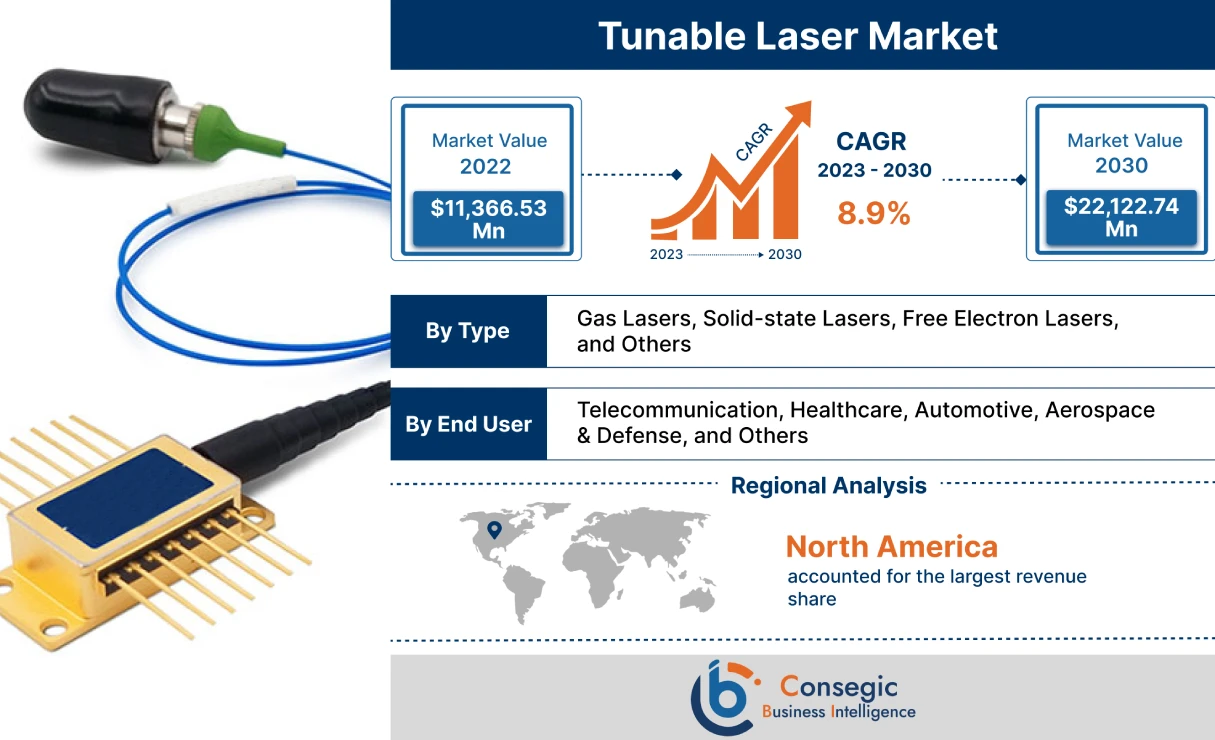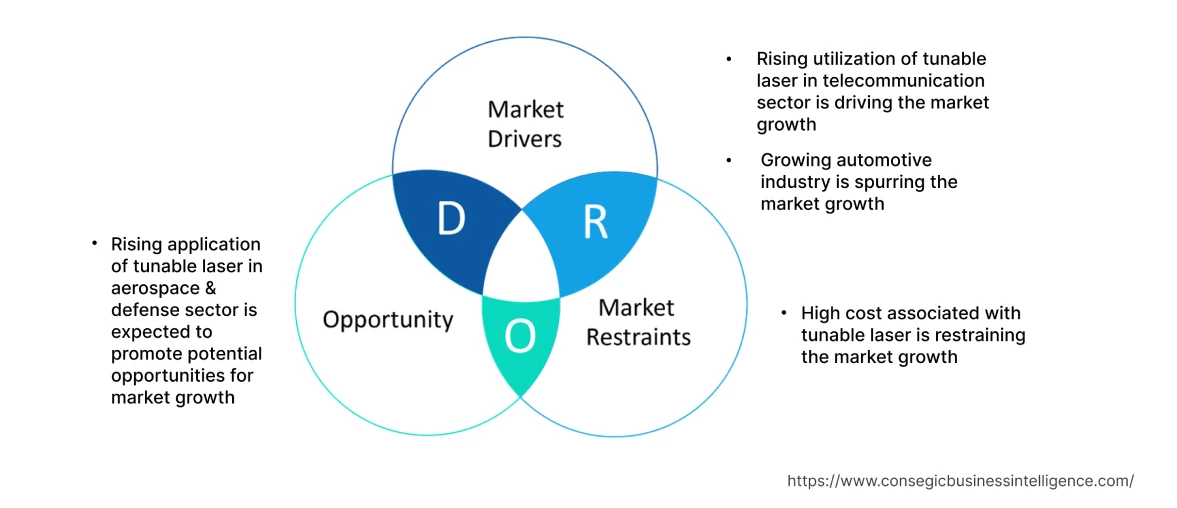Tunable Laser Market Size :
Tunable Laser Market size is estimated to reach over USD 22,122.74 Million by 2030 from a value of USD 11,366.53 Million in 2022, growing at a CAGR of 8.9% from 2023 to 2030.
Tunable Laser Market Scope & Overview:
Tunable lasers refer to a type of laser whose wavelength of operation can be adjusted in a controlled manner. They are primarily composed of a gain section, a phase section, and a mirror section, which helps generate an adjustable phase shift between the reflector and gain material. They offer a range of benefits including constant change in wavelength emissions, high data conveying limit, lower spin spillage, and others. The aforementioned benefits of these lasers are key determinants for increasing its deployment in telecommunication, healthcare, automotive, aerospace & defense, and other industries.
Tunable Laser Market Insights :
Tunable Laser Market Dynamics - (DRO) :
Key Drivers :
Rising utilization of tunable lasers in the telecommunication sector is driving the market.
Tunable lasers are primarily used in the telecommunication sector for application in fiber optics communication systems. They are capable of populating various channel slots and reducing laser inventory while providing a route to reconfigurable WDM (wavelength division multiplexing) systems. Additionally, a laser serves as a spare in case of failure of one of the fixed-wavelength lasers for particular channels in the fiber optics communication system. The above characteristics of lasers are prime aspects for increasing its utilization IT & telecommunication sector. Factors including the growing penetration of 5G infrastructure, increasing demand for wireless communication, and rising adoption of smartphones and communication devices are among the primary determinants for driving the telecommunication sector.
- For instance, according to the Ookla 5G Map, 5G deployments reached 112 countries in November 2021, witnessing a growth of 13% as compared to 99 countries in November 2020. Ookla further states that the overall number of 5G deployments increased considerably and reached up to 85,602 deployments in 2021 in comparison to 17,428 deployments in 2020.
Thus, the rising penetration of 5G networks along with the growing telecommunication sector is increasing the adoption of tunable for its application in fiber optics communication systems, in turn driving the tunable laser market growth.
The growing automotive industry is spurring the market progress.
A tunable laser is used in the automotive sector for applications including LiDAR and high-resolution sensing applications among others to enable vehicles to sense and understand their surroundings. The deployment of these lasers in the automotive sector plays a crucial role in advanced driver-assistance systems (ADAS) and autonomous vehicle applications among others. Factors including the increasing production of automobiles, advancements in autonomous driving systems, and the growing need for enhanced automobile sensor solutions and safety are driving the sector.
Hence, the growing automotive sector is increasing the adoption of lasers for utilization in automotive LIDAR and high-resolution sensing applications, in turn proliferating the tunable laser market demand.
Key Restraints :
The high cost associated with tunable lasers is restraining the market demand.
The high cost associated with tunable lasers is a key factor restraining the market. These lasers often require advanced materials and complex manufacturing processes, driving up their production costs. As a result, they can be expensive for consumers, particularly in industries with tight budgets or those that require large-scale deployment. The initial investment and maintenance costs further deter potential buyers, limiting the adoption of tunable lasers across various sectors. This makes it challenging for the market to expand, especially in price-sensitive applications.
- For instance, AssetRelay offers a wide variety of lasers with average prices ranging from USD 2,500 to USD 13,000 per unit, depending on the type and specification of the laser.
- Additionally, Optilab provides various types of lasers including C-band and L-band tunable lasers with average cost ranging from USD 3,900 to USD 16,000 per unit, which is relatively very high.
Hence, analysis of market trends depicts that high costs associated with the utilization of lasers are restraining the tunable laser market growth.
Future Opportunities :
The rising application of tunable lasers in the aerospace & defense sector is expected to promote potential opportunities.
The rising application of tunable lasers in the aerospace & defense sector is expected to present potential market opportunities. They are utilized in the aerospace & defense sector for applications including remote sensing & imaging, targeting & ranging, laser illuminators, and other related applications. Moreover, they are also utilized in fiber optics communication systems for providing secure and high-speed communication between aircraft, ground stations, and satellites. Factors including growing commercial flight activities, rising aircraft production, and increasing investments in air defense systems are fostering the rise of the aerospace & defense sector.
- For instance, Boeing, a U.S.-based airline company, delivered 99 commercial jets in the fourth quarter of 2021, witnessing a significant increase of 68% as compared to 59 deliveries in the fourth quarter of 2020.
Therefore, the market trends analysis shows that the growing aerospace & defense sector is anticipated to increase the application of tunable lasers for aforementioned applications, in turn promoting tunable laser market opportunities during the forecast period.
Tunable Laser Market Report Insights :
| Report Attributes | Report Details |
| Study Timeline | 2017-2030 |
| Market Size in 2030 | USD 22,122.74 Million |
| CAGR (2023-2030) | 8.9% |
| By Type | Gas Lasers, Solid-state Lasers, Free Electron Lasers, and Others |
| By End-User | Telecommunication, Healthcare, Automotive, Aerospace & Defense, and Others |
| By Region | North America, Europe, Asia-Pacific, Latin America, Middle East & Africa |
| Key Players | Coherent Corp., EKSPLA, EXFO Inc., HUBNER Photonics, Amplitude Laser, Luna Innovations, Newport Corporation, Santec Corporation, Thorlabs Inc., and TOPTICA Photonics AG |
Tunable Laser Market Segmental Analysis :
By Type :
Based on the type, the market is segmented into gas lasers, solid-state lasers, free electron lasers, and others.
The solid-state lasers segment accounted for the largest revenue share of the overall tunable laser market share in the year 2022. Solid-state lasers are a type of laser that utilizes a gain medium that is solid and composed of glass or crystalline host material. Moreover, solid-state lasers offer several benefits including flexible design, high efficiency, excellent wavelength adjustability, high output power density, and strong power scaling ability. The above benefits of solid-state lasers are increasing their application in telecommunication, automotive, aerospace & defense, and healthcare sectors among others.
- According to Viavi Solutions Inc., the total number of cities with 5G networks reached 1,947 worldwide as of January 2022, with the addition of 635 new 5G cities in 2021.
Thus, analysis of segmental trends portrays that the growing telecommunication sector is among the key factors driving the adoption of lasers for utilization in broadband and fiber optic communication systems, in turn contributing to the market.
The free electron lasers segment is anticipated to register the fastest CAGR during the forecast period. Free electron lasers are capable of directly converting the kinetic energy of the electron beam into light. Free electron lasers generate extremely bright and short pulses of radiation. Moreover, free electron lasers offer various benefits including high wavelength adjustability, wide frequency range, coherent radiation, and others. The above benefits of free electron lasers make it ideal for utilization in aerospace & defense, healthcare, and other industries.
- For instance, in December 2022, Dassault Aviation, a France-based manufacturer of military aircraft and business jets, launched its new Rafale fighter aircraft for its application in the French military procurement agency called the Directorate General of Armaments. Free electron lasers are often employed in the aerospace & defense sectors for applications including antiaircraft and anti-missile directed-energy weapons, along with targeting & ranging applications.
Therefore, the segmental trends analysis shows that rising production from the aerospace & defense sectors is anticipated to drive the tunable laser market trends during the forecast period.
By End-User :
Based on the end-user, the tunable laser market is segregated into telecommunication, healthcare, automotive, aerospace & defense, and others.
The telecommunication segment accounted for the largest revenue share of 29.6% of the overall tunable laser market share in the year 2022. Factors including the growing penetration of 5G infrastructure, increasing demand for wireless communication, along rising need for high-speed data and cloud-based services are driving the telecommunication sector.
- For instance, according to the GSM Association, the majority of countries in Europe deployed commercial 5G services in 2021, and approximately two-thirds of operators in the region launched 5G networks. GSM Association also states that 5G connections across Europe are projected to reach 311 million by 2025.
Therefore, analysis of segmental trends depicts that the growing telecommunication sector is driving the adoption of lasers for utilization in base stations and fiber optic communication systems among others, in turn proliferating the tunable laser market trends.
The automotive segment is expected to witness the fastest CAGR during the forecast period. The rising automotive segment is attributed to several factors including rising investments in the expansion of automotive manufacturing facilities, increasing automobile production of automobiles, and advancements in autonomous driving systems.
- For instance, according to ACEA (European Automobile Manufacturers Association), the production of passenger cars in the European Union reached 10.9 million in 2022, witnessing an increase of 8.3% as compared to 2021. A laser is primarily used in the automotive sector for applications including LIDAR and high-resolution sensing applications to enable vehicles to sense and understand their surroundings.
Thus, the segmental trends analysis shows that rising automotive production is projected to drive the adoption of lasers, in turn driving the tunable laser market demand during the forecast period.
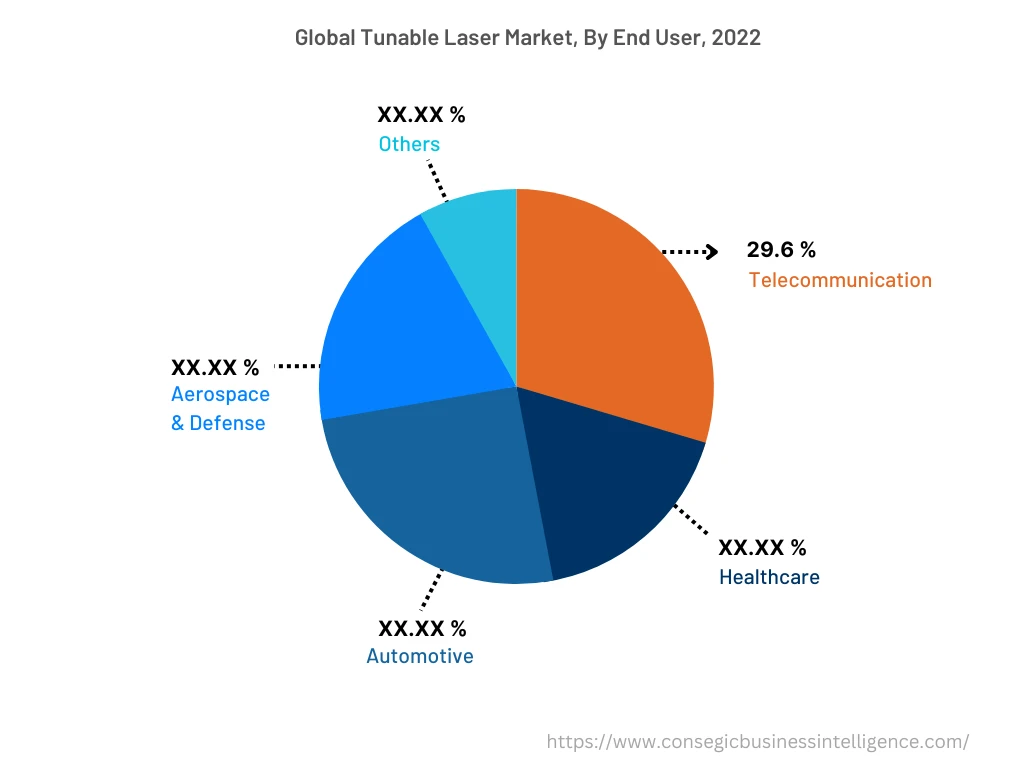
By Region :
The regional segment includes North America, Europe, Asia Pacific, the Middle East and Africa, and Latin America.
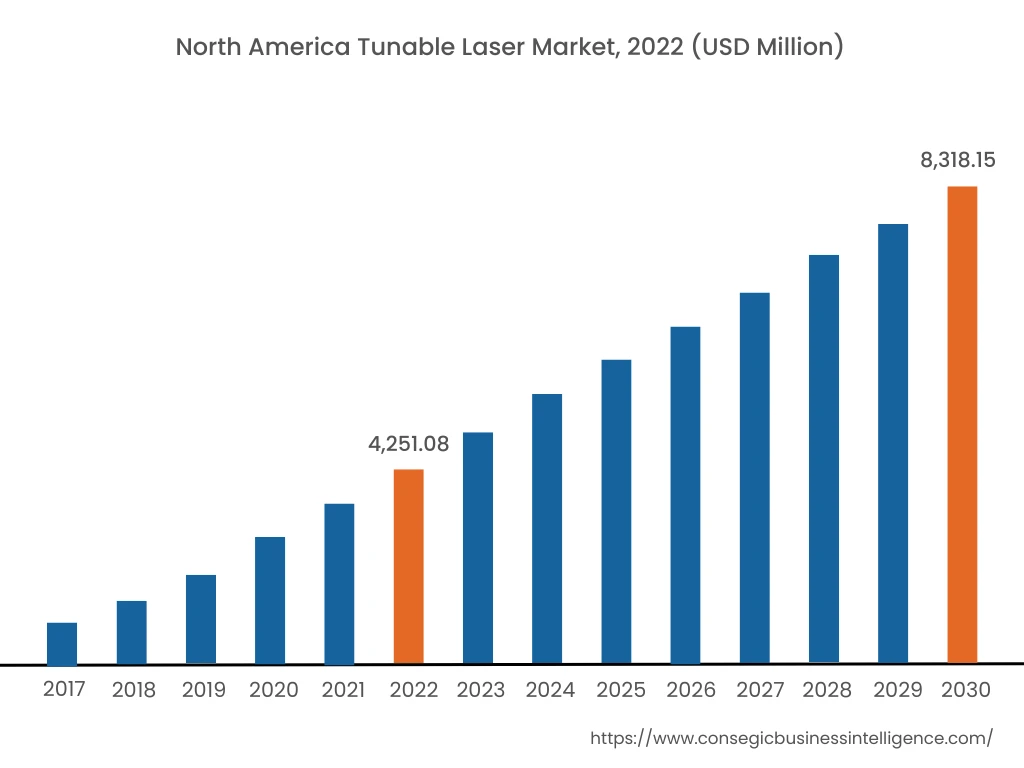
North America accounted for the largest revenue share of USD 4,251.08 Million in 2022 and is expected to reach USD 8,318.15 Million by 2030, registering a CAGR of 9.0% during the forecast period. In addition, in the region, the U.S. accounted for the maximum revenue share of 55.6% in the same year. The adoption of tunable lasers in the North American region is mostly driven by its utilization in telecommunication, automotive, healthcare, and other sectors. Moreover, the increasing utilization of lasers in networking and telecommunications infrastructure including base station and fiber optic communication systems is among the significant factors driving the market development in the region.
- For instance, according to the GSM Association, approximately 140 million 5G connections were deployed across North America as of 2022.
Hence, the growing telecommunication industry is propelling the deployment of lasers for high-speed data transfer and communication applications, in turn fostering market development in the North American region. Additionally, increasing investments in the aerospace & defense, and healthcare industries are anticipated to promote lucrative growth aspects for the tunable laser market expansion in North America during the forecast period.
Asia-Pacific is expected to register fastest CAGR of 9.2% during the forecast period. The growing pace of industrialization and development is creating lucrative growth aspects for the market in the region. Moreover, as per the tunable laser market analysis factors including the growth of multiple industries such as telecommunication, automotive, and others are fostering the market in the Asia-Pacific region.
- For instance, according to the Society of Indian Automobile Manufacturers, the total automotive production in India reached 2,59,31,867 units from April 2022 to March 2023, depicting an incline of 12.6% from 2,30,40,066 units from April 2021 to March 2022.
Hence, the growing automotive sector is anticipated to drive the utilization of tunable lasers for deployment in automobile LIDAR and 3D sensing applications, thereby, proliferating the tunable laser market expansion in the Asia-Pacific region during the forecast period.
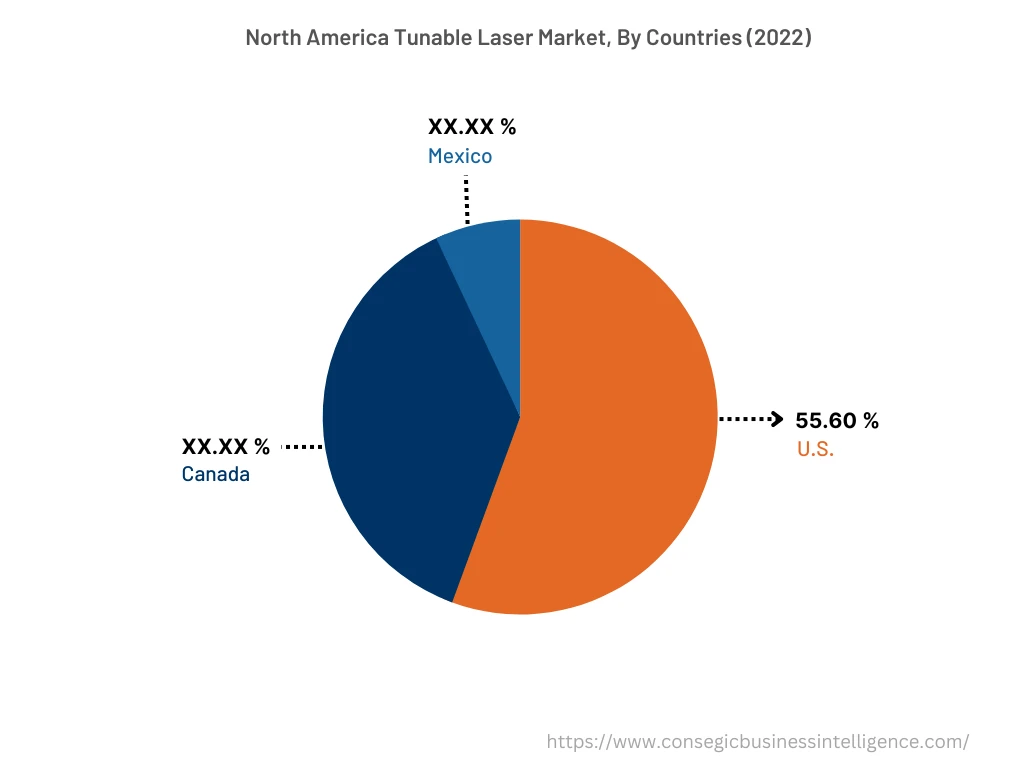
Top Key Players & Market Share Insights:
The tunable laser market is highly competitive with major players providing products to the national and international markets. Key players are adopting several strategies in research and development (R&D), product innovation, and application launches to hold a strong position in the global tunable laser market. Key players in the tunable laser industry include -
- Coherent Corp.
- EKSPLA
- Santec Corporation
- Thorlabs Inc.
- TOPTICA Photonics AG
- EXFO Inc.
- HUBNER Photonics
- Amplitude Laser
- Luna Innovations
- Newport Corporation
Recent Industry Developments :
- In March 2021, Santec Corporation launched its new tunable laser TSL-57, which offers high stability and fast scan capability. The tunable laser utilizes an optical cavity design integrated with precise speed control along with sub-picometer resolution and accuracy.
Key Questions Answered in the Report
What is tunable laser? +
Tunable lasers refer to a type of laser whose wavelength of operation can be adjusted in a controlled manner. Tunable lasers are primarily composed of a gain section, phase section, and a mirror section, which helps in generating an adjustable phase shift between the reflector and gain material.
What specific segmentation details are covered in the tunable laser report, and how is the dominating segment impacting the market growth? +
For instance, by type segment has witnessed solid-state as the dominating segment in the year 2022, owing to its increasing utilization in telecommunication, automotive, aerospace & defence, and healthcare sectors among others.
What specific segmentation details are covered in the tunable laser market report, and how is the fastest segment anticipated to impact the market growth? +
For instance, by end-user segment has witnessed automotive as the fastest-growing segment during the forecast period due to the rising adoption of tunable lasers in automotive LIDAR and high-resolution sensing applications.
Which region/country is anticipated to witness the highest CAGR during the forecast period, 2023-2030? +
Asia-Pacific is anticipated to register fastest CAGR growth during the forecast period due to rapid pace of industrialization and growth of multiple industries such as telecommunication, automotive, healthcare, and others.
